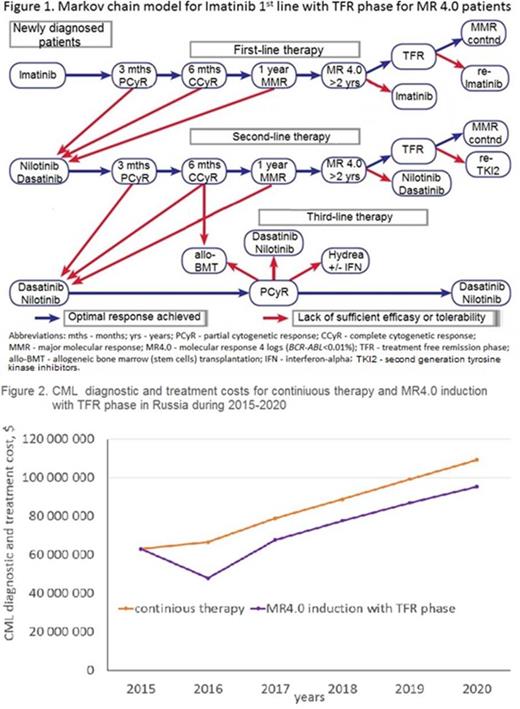Abstract
Introduction. Implementation of target therapy in chronic myelogenous leukemia (CML) treatment allowed saving life for majority of CML patients. First and second generation tyrosine kinase inhibitors (TKI) usage experience showed that part of patients can achieve deep molecular responses. Clinical trials of treatment cessation in CML patients with deep molecular response demonstrated that substantial proportion of patients can be free from drug with predictable relapse risk and safe treatment re-initiation. This approach is interesting due to sustained increasing number of CML patients and avalanche like increment of budget burden because of continuous expensive TKI therapy.
The aim of our study was to assess potential budget impact of successful TKI cessation in CML patients with long-lasting deep molecular response.
Materials and methods. Pharmacoeconomical modelling of CML diagnostic and treatment process including treatment free remission (TFR). Markov chain approach was implemented to construct models for non-stop therapy and TFR in patients with sustained molecular response 4 logs (MR4.0) (Fig 1). Treatment re-initiation was considered in case of major molecular response loss. The total number of CML patients in Russia was 6500; annual rate of newly diagnosed CML cases was 800 (in accordance with Russian CML Registry data). The patient consent rate to TFR inclusion was assumed as 80%. Transition rates were chosen from clinical trials and own experience. Cost-utility analysis of first and second generation TKI apply was performed. Simulation of clinical and economical consequences was done on national level. Five-year (2015-2020) time horizon was used. To simplify presentation of our results we recalculated costs to US dollars.
Results. Our analysis showed that by year 2020 the estimated total CML patient number in Russia will be about 11000 patients with total direct yearly CML cost 109 mln $. TFR approach can decrease budget burden from 109 to 95 mln $ yearly and the total evaluated money saving during years 2015-2020 period in Russia will be 67 mln $ with complement cost-utility data (Fig 2).
Conclusion. Annual CML cost will increase due to increment of CML patients number. Nevertheless, TFR strategy in CML patients with long-lasting deep molecular response under continuous molecular monitoring can significantly decrease the healthcare budget burden. TFR approach has the advantage over sustained therapy on financial cost and efficacy of its use.
Turkina:Bristol Myers Squibb: Consultancy; Pfizer: Consultancy; Novartis Pharma: Consultancy.
Author notes
Asterisk with author names denotes non-ASH members.


This feature is available to Subscribers Only
Sign In or Create an Account Close Modal